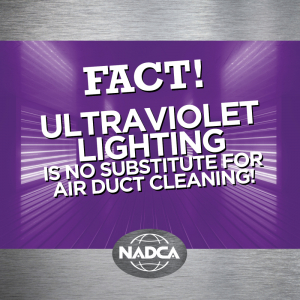Disinfection: UV Lighting is no Substitute for Duct Cleaning!
Disinfection of airborne pathogens and the use of ultraviolet type C (UVC) radiation generated by UVC lamps is a hot topic in the fight against the transmission of SARS-CoV-2 (the virus that causes COVID-19). However, after examining several key reports and research on the topic, NADCA’s position on this is clear. As stated in our “Ultraviolet Lighting Applications in HVAC Systems” white paper on the topic, “Ultraviolet lighting does not clean HVAC systems, and should not be used as a substitute for HVAC cleaning.”

It is generally agreed that source removal of contaminants is still the single best method for cleaning and decontaminating HVAC systems. Although there have been many studies performed as to the effectiveness of UVC lamps in inactivating the SARS-CoV-2 virus, there is limited published data about the wavelength, dose, and duration of UVC radiation required to consistently do so.
UVC lights have been proven to reduce the spread of bacteria like tuberculosis. UVC light does destroy the outer coating of the SARS coronavirus, but that virus differs from the current SARS-CoV-2 virus that causes COVID-19.
As of now, the Food and Drug Administration (FDA) has not conclusively found evidence to support that UVC light will neutralize or “kill” this specific, new virus. This unknown is being factored into the chance that UVC lighting may be another, formidable way to fight COVID-19.
UVC lamps are commonly used inside air ducts within a facility, as it avoids humans from having direct exposure to the radiation which could cause severe injuries to a person’s eyes and acute or long-term damage to their skin.
The most common use of UVC is to inactivate mold and stop it from building up on coil in the HVAC system. When the UVC light is mounted directly for constant exposure onto the coil, it will neutralize most mold, bacteria, and viruses. The use of ultraviolet germicidal irradiation (UVGI) in HVAC systems has been studied and reviewed extensively by many scholars internationally, and by professional organizations such ASHRAE.
However, a major challenge that we face with UVC light is that it needs to be directly exposed to the pathogen it is fighting. Dust or soil can inhibit the ability of UVC light to inactivate a virus, as it may block the virus’s direct exposure to the UVC light.
Also, a virus will not be inactivated if it is embedded in a porous surface or on the underside of a surface. There is uncertainty about the length of time that the SARS-CoV-2 virus needs to be exposed to the UVC light to completely inactivate it. If the virus is traveling within dust particles through the ductwork, and it is not being exposed to the UVC lamp long enough because of the air flowing at a rapid CFM rate of speed, there is a chance that the UVC lamp will not fulfill its desired results.
NADCA’s position is that, when used in tandem with proper HVAC cleaning procedures, “the application of UVGI in HVAC systems can be an effective means to reduce airborne pathogens, but only if lamps are properly and strategically installed in sufficient number and/or intensity, and are properly maintained.”
To increase the probability of the virus being inactivated, fresh outside air and recirculated air must travel through clean HVAC components and ductwork. Time and again, companies are called to clean ductwork during a UVC lamp installation to increase the odds that the intended pathogens are killed. The coil also should be cleaned to ensure that the debris accumulated on it is not interfering with the intended purpose of the UVC light. Cleaning will also help immeasurably with the coil function.
Although the information in this article reflects what is currently available on the use of UVGI in HVAC systems, readers should recognize that new developments regularly occur, and should stay current on information when determining the appropriate steps to take. Also, it is important to recognize that differences in opinion will exist as to how to manage the use of UVGI in HVAC systems, and that the decision of whether to use it rests with the owner of the HVAC system.
Click Here to Read the “Ultraviolet Lighting Applications in HVAC Systems” White Paper
Article originally written by Michael D. Vinick, ASCS, CVI. Vinick is a current member and past President of NADCA. He is also the President of Duct & Vent Cleaning of America, Inc., located in Springfield, Massachusetts.
